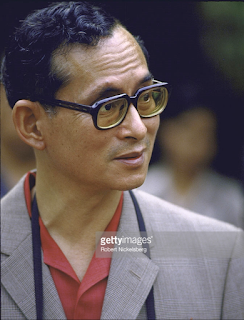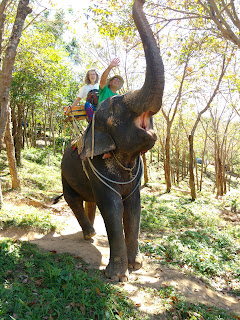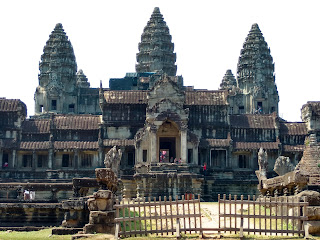We arrived in Thailand to discover that the country is still in mourning over the death last year of King Bhumibol Adulyadej, or Rama IX to you and me, whose image, usually as a young man, is everywhere displayed on billboards, buildings, fences, traffic circles, pagodas and pretty much anywhere there's any available public space, always accompanied by black and white bunting - sometimes miles of it. Oh, to be in the bunting business. This guy has more exposure than Santa Claus on Christmas. Even the casual visitor is told, several times a day, of the tragic loss of the sovereign, and of the certainty that his memory will linger in his subject's hearts forever. For example, it's become part of the pre-flight safety talk, as important as what to do in the unlikely event of a water landing. It would all be very touching if it were sincere, and it well may be, but there's no way to know since even a whiff of criticism of the king, or anyone close to him, is strictly verboten, punishable by years in prison. This fatwa applies anywhere and everywhere, even perhaps to blogs that are unlikely to be read by more than 5 people, which is why you won't get to read this one until its author is safely out of the country. The deceased king, who reigned for 70 years, was closely associated with a series of military regimes, and is presumed to have played a major role in the government massacre of dozens of student demonstrators in the 70s, which is enough for me to hold off on unending adoration. Which is not to say he was not truly beloved by "the people". If the Russian people can overwhelmingly endorse Putin, another known murderer of his political adversaries, and if the American people can elect you-know-who, then we shouldn't be surprised if the Thai people really loved this guy, who, I must admit, does look kinda lovable in the millions of images one can't escape seeing every day. He looks more like a sincere graduate student of, say, classical poetry, than like the pompous potentate you might expect, or even Yul Brenner. But it felt rather creepy, at least for this westerner, to be required to stand while his praises were sung at the start of a movie, and to notice the reverence that the ritual seemed to elicit in the rest of the audience. Fun fact: the king was an American, or at least could have been. He was born in Massachusetts.
Bangkok, long high on my bucket list, is a huge, modern city with dozens of third world shantytowns occupying the interstices between the skyscrapers. Sort of a mashup of Hanoi and Dallas. You walk along teeming alleys where excellent street food is being grilled on every block and aggressively hawked for a pittance, and then step into a high rise shopping mall that wouldn't be out of place in New Jersey, except it really would be because it's bigger and better than anything in New Jersey. We went to a rooftop bar one night (800 ft above the city) where a couple of ordinary drinks cost us close to $50, and then had a superb dinner at street level for a tenth of that. City of contrasts.
As first time tourists to Bangkok we hit all the iconic Buddhist temples and monuments, which are world class versions of the Buddhist temples and monuments a tourist sees all over Asia. These are active houses of worship, but they seem to be trying to outdo each other on the flamboyance scale. Take, for example, Wat Pho, next to the grand palace in the old part of town. It houses a 46 meter long, guilded, reclining Buddha, in addition to hundreds of other Buddhas aligned in stately rows. There are over a dozen enormous bejeweled towers, called chedis, and countless bits of lesser statuary, some of it quite playful. The whole effect is a feast for the eyes. I have the impression that Buddhist temples, in general, aim to be fun to look at, and Bangkok has some of the top examples of this anywhere. Of course, churches also strive to be beautiful, and one feels almost compelled to compare the two. In fact, the largest temples beg comparison to cathedrals. In both cases, the builders aim for grandeur, beauty, and of course artistry, but the results are very different. The best cathedrals, while often gaudy, are filled with beauty, to the point of leaving the visitor awestruck, and also somewhat humbled. The mood is sombre, perhaps following the lead of the central Christian image of a dead man still attached to the device that killed him. (It's only a slight shift in the culture of brutality over the ages that saves Christians from praying to a hanged man every Sunday.) Buddhism isn't burdened with such images, which may explain why its "cathedrals," seem like happier places. They too are filled with beauty, and they're no less gaudy, but the visitor doesn't feel awed so much as wowed. I think Beth got it exactly right when she noted that Wat Pho has pazzaz; Chartres doesn't.
Against all advice we decided to go to the island of Phuket. Apparently, it is the accepted wisdom that Phuket is too touristy, too built up, too commercial and too 1970s. We found none of that to be the case, but, in fairness to the critics, I concede that the taxis are too expensive. Other than that, it's basically a tropical paradise. So as not to stoke envy, I'll spare you the details. We had planned to spend about a week on Phuket and then make our way to Krabi, on the other side of Phang Nga bay, which is alleged to be even more beautiful than Phuket, but our plans ran afoul of the core purpose of this entire expedition: dental tourism. In order to fulfill my lifelong dream of saving thousands of dollars on medically unnecessary crowns, I would have to return to Bangkok too soon to make it to Krabi, so we ended up spending a little over a week on Phuket and then heading directly back to Bangkok. This was hardly unbearable, and it provides an excuse for returning to the region next year, as if one were needed.
A word on medical/dental tourism: it's the best idea since sliced bread (I hate that expression: sliced bread is a terrible idea, but you know what I mean.). Among America's many afflictions, the outrageously expensive and inefficient medical system is hardly a secret, but fleeing from it whenever possible is a surprisingly underused strategy. The medical monopoly in America has gotten so out of hand that it's almost always worth it to take your elective medical business elsewhere, even considering the associated travel expenses. Of course the key word here is elective; most American heath insurance schemes effectively force you to stay in the country and use the local overpriced services, but retirement has freed me from dental insurance, so here I am in Bangkok having my unflattering incisors replaced with elegant new ones at a quarter of the cost in New York. It almost pays for the trip.
I can't write about Thailand without talking about the food. For decades I have been deeply enamored of Thai cuisine, to the point that friends consider it a very annoying quirk. So just being here makes me feel like a kid in a toy store. Thai food 3 meals a day! I can now report, after 3 weeks, that the food here is delicious, and I am quite happy having chicken curry and pad Thai for breakfast. I won't leave the country, though, spoiled for eating Thai food in New York or San Francisco, as I was with French food after living in France. I can point to instances where the food here surpasses its American counterpart, but for the most part it doesn't, and I will continue to annoy my friends by suggesting Thai as the default cuisine whenever restaurants are being considered. Of course America lacks the street food culture that is ubiquitous here. There are uncountable thousands of little food carts offering grilled meets and fish, wonderful soups and curries, spicy salads and fruit drinks, all for pocket change. And the high end restaurants turn out one richly flavored dish after another, often at a level of spiciness you rarely find anymore back home. Sadly, those high end restaurants, the ones with the impeccable, if often obsequious, service, seem to have an almost exclusively foreign clientele. We ate in several restaurants that certainly rated Michelin stars, if they gave them out here, which they don't, where none of the diners were Thai. One's discomfort at that is somewhat tempered by the knowledge that the locals are eating very well elsewhere, since this is clearly a country that appreciates good food at all levels of society.
If there's anything I like more than Thai food it's sex, and that seems to be offered up here much in the manner of the street food. Unlike the street food, I passed on the street sex, so you'll have to look elsewhere for an honest report (i.e., I can't make that first sentence truly parallel, and add another "Thai"), but I can pass on a few impressions. In some areas there are hundreds of hookers (I presume) sitting on stools in front of bars, massage parlors (a big thing here, not per force sexual) and sometimes just plain doors, eager to make eye contact with any passing male, especially western males, who for some reason seem to make up a large percentage of the pedestrians in these areas. The girls are somewhat like the tuktuk drivers in that they seem to mostly sit around waiting for work. (Those tuktuks, also, are everywhere, each with a driver who must say, a thousand times a day, "where are you going?" to everyone who walks by). What's striking to a traveler used to the prudish confines of the United States is both the extent and the openess of it all. There are red light districts everywhere, but not like these. And this in a country where a strict dress code (no exposed knees or shoulders, no matter what the temperature) is enforced in many temples and museums. I'm aware that there's a strain of political correctness that condescendingly regards this business as exploitive, especially the sexual tourism aspect of it that seems to predominate here, but I disagree (save for the minors who may well be swept up in it). It's no more exploitive than the tuktuk business, or, no doubt, dozens of other businesses that rely on the huge pool of underemployed people in this country, and pretty much everywhere else, for that matter. But while not exceptionally exploitive, there is an aspect of it that invoked a sadness beyond the normal sympathy one feels for all these people doing dead end jobs; I'm referring, of course, to the costumers. If you watch for a while, you notice couples on bar stools or just strolling in the lanes - middle aged, or older western guys with Thai women half or a third their age, and often half or a third their size. They talk intimately (in what language?) and smooch in a way that you don't see with hookers and their clients on the seedier streets of New York. These guys are here for the girlfriend experience, or maybe even the wife experience. Not all of them, for sure, but a lot of them. I can only guess at the kinds of personal failures and disappointments that would drive a person to fly to the other side of the world to try to buy a girlfriend. There but for fortune, eh,?


 |
| Rooftop bar |
 |
| Bangkok mall with Golden Gate bridge |
 |
| Tourists |
 |
| Near Phuket |
 |
| Phuket |
 |
| Wat Pho |
 |
| Chedi |











